It is a vivid memory to this day: I was working at the Diving Locker in Vancouver, Canada. One rainy day, Jim, a fellow dive instructor and old friend, dashed in and said he had bought a dive shop in Lahaina, Maui, Hawai’i, and had moved his 48-foot sailboat there. He needed someone to live on the boat and would get me a job in the dive shop. At that moment the sun came out and a rainbow appeared. I asked if this was some sort of a trick question. Thinking I could do that for a year, I said, “Sure.” That was 1986. Six years later the shop was gone, the boat was gone, but I stayed and made Maui my home. There have been many changes in my 33 years there, but I still jump into the surrounding Pacific Ocean at least once a week.
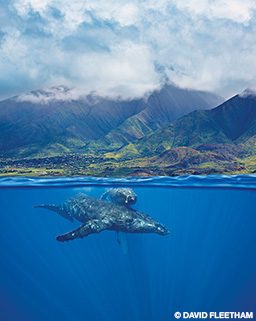
First-time divers coming to Maui often think it is just one island. Maui County, however, is composed of Maui, Lana’i, Moloka’i and Kaho’olawe and is the only county in the state to contain multiple islands. When returning to Maui from Lana’i on a clear day you can see the peaks of the Big Island (Hawai’i) and all four Maui County islands. It is the only place to view five Hawai’ian islands at the same time.
Cross off Kaho’olawe from your dive list though. After the attack on Pearl Harbor in World War II, the U.S. military used the island as a bombing range until 1990, when President George H.W. Bush ordered an end to the operations. After an exhaustive but imperfect $400 million ordnance removal operation, the state legislature of Hawai’i established the Kaho’olawe Island Reserve, which includes the island and surrounding waters in a 2-mile radius from its shore. All commercial uses, including scuba diving, are prohibited. When the island was being bombed, the military opened it for diving on the last weekend of each month. I have fond memories of many amazing dive sites there. I’m somewhat sad that diving is now prohibited, but I’m glad that those ridges and caverns with their huge schools of jacks and sharks are thriving without human influence.
Each island has at least one nickname. Maui (the Valley Isle) was formed over millions of years by two distinct volcanic occurrences. Mauna Kahalewai (the West Maui Mountains) form the older of the two volcanic eruptions, evidenced by the advanced stage of erosion there as compared with the younger slopes of the 10,023-foot Haleakalā, which eventually formed the eastern side of the island and the connecting valley. An interesting phenomenon known as the Venturi effect occurs as the northeastern trade wind funnels through the valley. On a regular trade wind day, the waters around Maui can become a challenge for vessels as well as divers. Many dive boats depart early, so you may have to leave your hotel before sunrise for a 6 a.m. check-in. The advantage of this timetable is that you are often back at the harbor by noon and can enjoy the many other available activities. Not all days are blustery though, and there are afternoon choices for those who want to keep their gills wet.
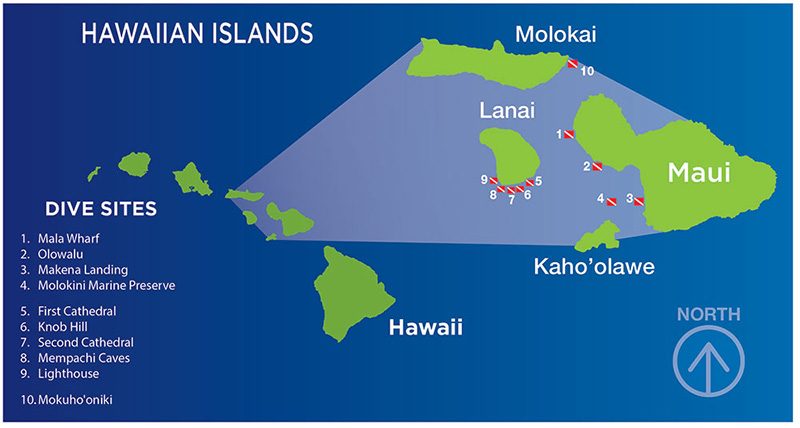

On the western side, Mala Wharf Pier is a good afternoon option, but it’s an even better night dive. You must wade in on the rocky shore, so booties are mandatory. The pier was built in 1922 for the pineapple trade and was partially destroyed by the first hurricane that came near the islands. In 1992 Hurricane Iniki decimated what was left. Large slabs of concrete and pillars litter the bottom out to 35 feet. The convoluted structures have become home to green sea turtles along with whitetip reef sharks, which like to rest on the sandy bottom in the shade of the concrete. Mala also has an uncanny magnetism for Commerson’s frogfish. I have counted eight of these large camouflaged fish on a single dive, knowing that more were peering at me from their covert perch.
Another afternoon spot for diving or snorkeling is Olowalu, located 5 miles south of Lahaina. This 1,000-acre reef is the largest off Maui and holds coral colonies that are more than 300 years old. Both shore divers and charter boats frequent the area, which has been hit hard over the years by both man-made and natural occurrences. Coral bleaching hit the entire state in 2014 and 2015, killing 20 to 40 percent of Maui’s polyps.
In 2017 oceanographer and Mission Blue founder Sylvia Earle named Olowalu a “Hope Spot,” the first location in Hawai’i to receive this designation. It was selected due to the magnitude of the reef itself and the critical role it plays in fostering huge juvenile populations. A south swell, a common occurrence in the summer months, can drop visibility to a few feet. When visibility is clear, however, Olowalu is an impressive site with acres of finger coral dropping well offshore to the sand bottom at 80 feet. More than 400 individual manta rays have been identified in the waters here.
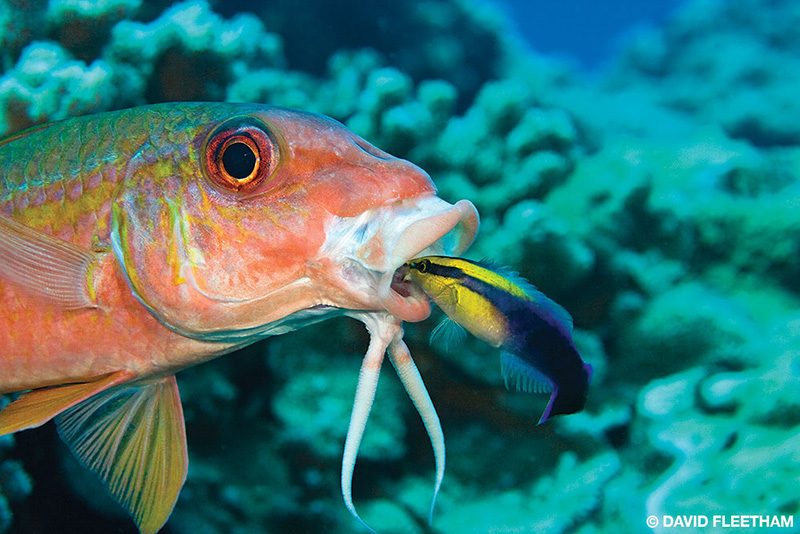
Makena Landing in South Maui is another good afternoon dive spot. After an easy entry on a small stretch of sand, a 150-yard surface swim leads to a dive site called Five Graves (also known as Five Caves or Turtle Town). The ominous name refers to five old headstones found near the two long lava fingers that comprise this site, which is full of swim-throughs, archways and caves along the ridges. It’s a favorite resting place for green sea turtles, schools of goatfish and an occasional eagle ray.
If you prefer to get on a boat, it’s helpful to know that in Hawai’i the dive charter boats are individual identities that are not associated with a resort. Maui County limits the number of charter permits, so choices are finite. At certain times of the year you will need to book a spot well in advance of your dive day, or you might find yourself without a spot on the boat. In West Maui, boats depart from Lahaina Harbor or Mala Wharf. To the south, vessels load up in Ma’alaea Harbor or the Kihei boat ramp. From these departure points the boats fan out to numerable dive destinations. After years as a boat captain for several companies, I have been to all the frequented sites, although some friends claim they can take me where I have never blown a bubble.
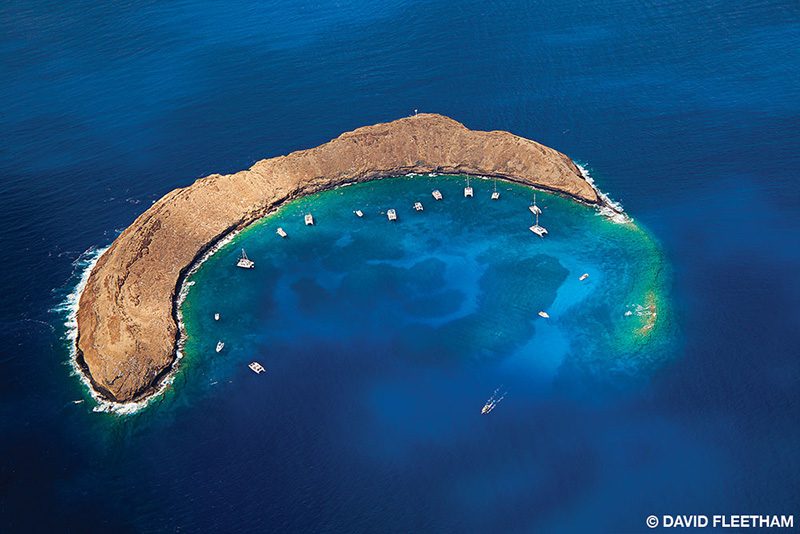
A site that stands out above the others, especially in the media, is Molokini Marine Preserve off South Maui. It is one in a series of vents that run down the side of Haleakalā and into the Alalakeiki Channel. Formed from compressed ash, the crescent-shaped islet reaches 160 feet above water. It is a bird sanctuary, so human visitors are not allowed on land. In the summer, nesting frigates take to the sky shortly after dawn and form a huge circling flock.
No matter how good the visibility is along the coastline, it is always better at Molokini. With visibility rarely less than 100 feet, sometimes when the planets align visibility can double to 200 feet or more. To eliminate any anchor damage to the reef, 26 day-use moorings are available. Most dive boats frequent Reef’s End and Enenue, the two corners of the crater. At Reef’s End the crater extends underwater, creating a submerged reef a few feet below the surface. A popular area for snorkelers, the crater continues out to the end of the reef, where it then drops off to the surrounding 300-foot bottom. Just inside this natural break wall is a sand channel that has historically been the welcome mat for pelagic visitors, including bottlenose dolphin, whale sharks and manta rays.
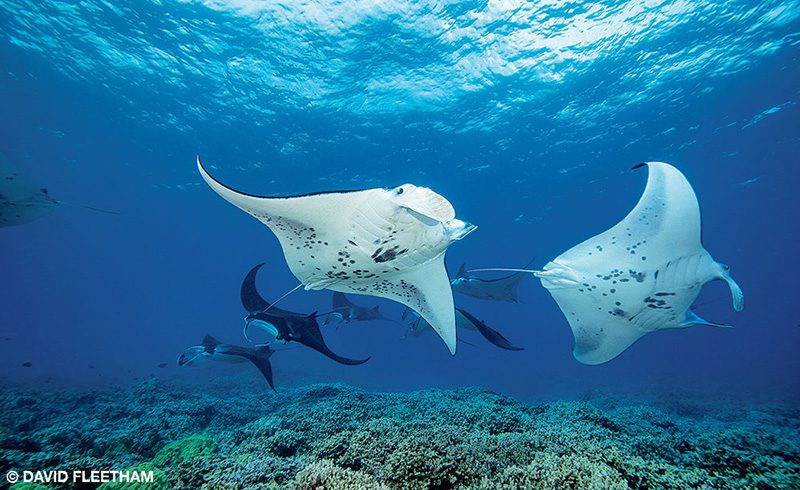
The Enenue corner has a more precipitous drop to the depths. Both points enjoy a healthy current when it is running, and the density of marine life mirrors the passing morsels this provides. Slabs of volcanic material form the perfect resting spot for whitetip reef sharks, who often put up with extended close encounters with divers simply due to the frequency of this circumstance. Most marine life at Molokini is approachable because of the daily encounters with hundreds of divers and snorkelers.
The outside of the crater, referred to as the Backwall, is a drift dive with no bottom in most sections — at least for sport divers. Out here you are likely to see gray reef sharks that occasionally visit a cleaning station where they attempt to vertically hover while Hawai’ian cleaner wrasse inspect them. While frogfish and crevices filled with soldierfish and lobsters keep divers focused on the reef, remember to look back and glance into the blue, where humpback whales invade Maui waters from December through March. A great white shark has been seen passing by the outside of the crater.
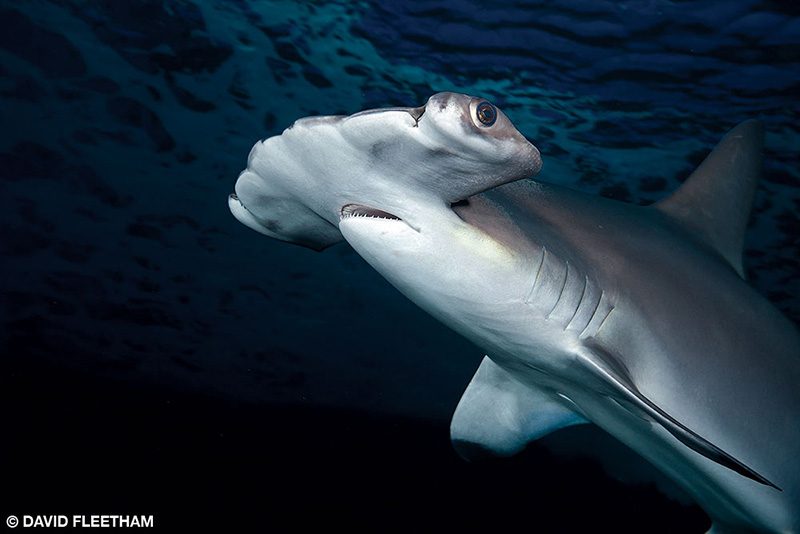
Most boats move to the South Maui coastline for a second dive at one of the many sites that range from lava ridges to reefs and even a wreck dive. Divers can often see varying numbers of green sea turtles up and down the coast.
The sixth-largest of the Hawai’ian Islands, Lana’i was once known as the Pineapple Isle because of its large pineapple production from 1922 to 1992. Oracle CEO Larry Ellison purchased 97 percent of the island in 2012. Accommodations include Hotel Lanai in Lanai City and a resort near Hulopo’e Bay, which is a picture-perfect conservation area that a resident group of spinner dolphins visits almost daily. Sixteen boat moorings are maintained at dive sites along the southern shore of the island. Protected from the regular trade winds, the coastline has ideal conditions except for a southern swell that can decrease visibility and make diving difficult.

The area’s two most popular sites are huge caverns named cathedrals. First Cathedral, closest to Maui, breaks the surface in front of the iconic Pu’u Pehe Rock, an 80-foot volcanic monolith that stands just inshore. The main entrance at 45 feet has plenty of room for two divers to enter side by side. The room immediately opens up, and divers can see light filtering through the far wall like a stained-glass window, and a rock there is reminiscent of an altar. To the left, a wide crevice with a silt bottom stretches back into darkness and is a favorite spot for whitetip reef sharks, goatfish and soldierfish. A round exit at the back of the cavern is known as the Toilet Bowl, where the moderate swell surge concentrates to flush a departing diver out of the opening. In a heavy swell, dive guides will have you avoid this area and exit the same way you entered.
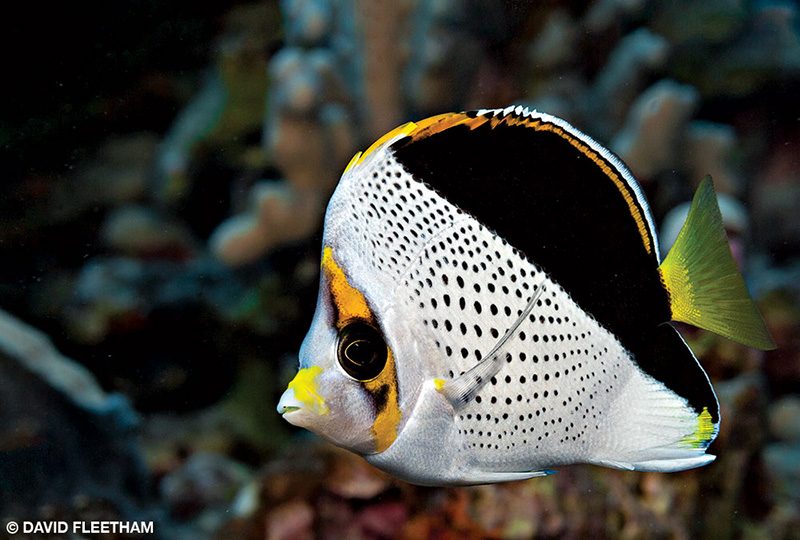
Second Cathedral, just past Hulopo’e Bay, does not break the surface. The cavern resembles a huge volcanic bubble that burst and then solidified, and its main room has many entrances and exits. While a light is not necessary, it is highly recommended to illuminate all the critters that hide in the corners. Among the many crustaceans that make their home here are eight different species of lobster and a variety of shrimp and crabs. Outside the cavern an enormous school of bluestriped snapper patrols the inshore side of the reef, which ends in a sandy bottom. Observant divers who regularly glance into the blue offshore can encounter an array of open-ocean creatures. On the seaward side, the reef has areas of broken coral that form patches of rubble, which is a favorite habitat for octopuses. I have visited reefs all over the world, and nowhere have I found this master of camouflage to be more plentiful than in Hawai’i.

Most dive trips include a stop at one of the caverns, but other excellent sites are less frequently visited. Lighthouse has an amazing lava tube where sharks are plentiful, Knob Hill is a favorite for octopuses, and Mempachi is a nudibranch hunter’s wonderland. Your boat will likely be the only charter visiting one of these sites, because the area’s dive operators have an unwritten rule to have only one group at a time on a dive site, which is not the case elsewhere on Maui.
An overview of Maui County would be incomplete without mentioning one last gem: Moku Ho’oniki Rock, located in the Pailolo Channel about 1 mile off the east end of Molokai. In Hawai’ian, “pailolo” means “crazy fisherman” — anyone would be crazy to try to navigate this channel to put fish on the table. The crossing can be challenging, but most dive operators watch the weather and pick an appropriate day for this location. It’s best to leave very early in the morning before the trade winds pick up. There is always a place to dive at Moku Ho’oniki, and the ride back to Lahaina is less choppy with the trade winds behind you.
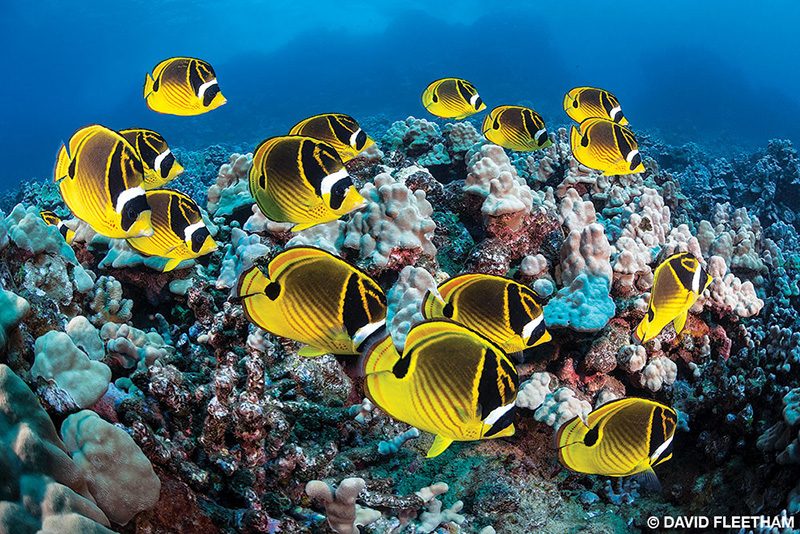
Any location around the rock is a good dive, but my favorite is Fish Rain, which is off the corner that faces Lana’i and slopes down to 110 feet. If you move in the direction of Maui, the slope becomes a substrate of boulders that also bottoms out at 110 feet. I have seen more scalloped hammerhead sharks here than anywhere else in the state. With a strong current often present, this dive is for experienced divers. Current is your friend for hammerhead sightings: They are few and far between when the ocean does not have motion. The rare and endemic titan scorpionfish is a regular here along with huge jacks that send schools of butterflyfish, damsels and bannerfish diving for the safety of the boulders.
Moisture in the trade winds brings showers to the windward side of Maui. Rarely a day passes without rainbows occurring in multiple locations around the island. When I see one, I am reminded of that pivotal day in the dive shop in Vancouver. While I regularly visit other underwater worlds, I am now a permanent fixture here in Maui, at the other end of the rainbow.
© Alert Diver — Q4 Fall 2019